Intel AX201D2 User Manual

Intel® WiFi Adapter Information Guide
This version of Intel® PROSet/Wireless WiFi Software is compatible with the adapters listed below. However, note that newer features provided in this software release are generally not supported for older, legacy adapters.
The following adapters are supported on this release for Windows* 10:
Intel® Dual Band Wireless-AC 7260
Intel® Dual Band Wireless-N 7260
Intel® Wireless-N 7260
Intel® Dual Band Wireless-AC 3160
Intel® Dual Band Wireless-AC 7265
Intel® Dual Band Wireless-N 7265
Intel® Wireless-N 7265
Intel® Dual Band Wireless-AC 3165
Intel® Dual Band Wireless-AC 8260 (64-bit only)
Intel® Dual Band Wireless-AC 8265
Intel® Wireless-AC 9260
Intel® Wireless-AC 9461
Intel® Wireless-AC 9462
Intel® Wireless-AC 9560
Intel® Wireless Gigabit 11000
Intel® Wireless Gigabit 11100VR
Intel® Wireless Gigabit Sink W13100
Intel® Wireless Gigabit Sink W13110VR
Intel® Tri-Band Wireless-AC 18265
Intel® Wi-Fi 6 AX201
The following adapters are supported on this release for Windows* 8 and Windows* 8.1 with Windows* 7 drivers from Intel®:
Intel® Centrino® Wireless-N 100
Intel® Centrino® Wireless-N 130
Intel® Centrino® Wireless-N 1000
Intel® Centrino® Wireless-N 1030
Intel® Centrino® Advanced-N 6200
Intel® Centrino® Advanced-N 6230
The following adapters are supported on this release for Windows* 8 with Windows* 8 drivers from Intel®:
Intel® Centrino® Wireless-N 105
Intel® Centrino® Wireless-N 135
Intel® Centrino® Wireless-N 2200
Intel® Centrino® Wireless-N 2230
Intel® Centrino® Wireless-N + WiMAX 6150
Intel® Centrino® Advanced-N 6205
Intel® Centrino® Advanced-N 6235
Intel® Centrino® Advanced-N + WiMAX 6250
Intel® Centrino® Ultimate-N 6300
Intel® Dual Band Wireless-AC 7260
Intel® Dual Band Wireless-N 7260
Intel® Wireless-N 7260
Intel® Dual Band Wireless-AC 3160
Intel® Dual Band Wireless-AC 3165
Intel® Dual Band Wireless-AC 3168
Intel® Dual Band Wireless-AC 7265
Intel® Dual Band Wireless-N 7265
Intel® Wireless-N 7265
Intel® Dual Band Wireless-AC 8260
The following adapters are supported on this release for Windows* 8.1 with Windows* 8 drivers from Intel®:

Intel® Centrino® Wireless-N 105
Intel® Centrino® Wireless-N 135
Intel® Centrino® Wireless-N 2200
Intel® Centrino® Wireless-N 2230
Intel® Centrino® Wireless-N + WiMAX 6150
Intel® Centrino® Advanced-N 6205
Intel® Centrino® Advanced-N 6235
Intel® Centrino® Advanced-N + WiMAX 6250
Intel® Centrino® Ultimate-N 6300
The following adapters are supported on this release for Windows* 8.1 with Windows* 8.1 drivers from Intel®:
Intel® Dual Band Wireless-AC 7260
Intel® Dual Band Wireless-N 7260
Intel® Wireless-N 7260
Intel® Dual Band Wireless-AC 3160
Intel® Dual Band Wireless-AC 3165
Intel® Dual Band Wireless-AC 3168
Intel® Dual Band Wireless-AC 7265
Intel® Dual Band Wireless-N 7265
Intel® Wireless-N 7265
Intel® Dual Band Wireless-AC 8260
Intel® Tri-Band Wireless-AC 17265
Intel® Tri-Band Wireless-AC 18260
Intel® Wireless Gigabit 11000
With your WiFi network card, you can access WiFi networks, share files or printers, or even share your Internet connection. All of these features can be explored using a WiFi network in your home or office. This WiFi network solution is designed for both home and business use. Additional users and features can be added as your networking needs grow and change.
This guide contains basic information about Intel adapters. It includes information about several adapter properties that you can set to control and enhance the performance of your adapter with your particular wireless network and environment. Intel® wireless adapters enable fast connectivity without wires for desktop and notebook PCs.
Adapter Settings
Regulatory Information
Specifications
Important Information
Support
Warranty
Glossary
Depending on the model of your Intel WiFi adapter, your adapter is compatible with 802.11a, 802.11b, 802.11g, and 802.11n (draft 2.0) wireless standards. Operating at 5GHz or 2.4GHz frequency at data rates of up to 450 Mbps, you can now connect your computer to existing high-speed networks that use multiple access points within large or small environments. Your WiFi adapter maintains automatic data rate control according to the access point location and signal strength to achieve the fastest possible connection. All of your wireless network connections are easily managed by the WiFi connection utility. Profiles that are set up through the WiFi connection utility provide enhanced security measures with 802.1X network authentication.
Information in this document is subject to change without notice.
© 2004–2014 Intel Corporation. All rights reserved. Intel Corporation, 5200 N.E. Elam Young Parkway, Hillsboro, OR 97124-6497 USA
The copying or reproducing of any material in this document in any manner whatsoever without the written permission of Intel Corporation is strictly forbidden. Intel® is a trademark or registered trademark of Intel Corporation or its subsidiaries in the United States and other countries. Other trademarks and trade names may be used in this document to refer to either the entities claiming the marks and names or their products. Intel disclaims

any proprietary interest in trademarks and trade names other than its own. Microsoft and Windows are registered trademarks of Microsoft Corporation. Windows Vista is either a registered trademark or trademark of Microsoft Corporation in the United States and/or other countries.
*Other names and brands may be claimed as the property of others.
Intel Corporation assumes no responsibility for errors or omissions in this document. Nor does Intel make any commitment to update the information contained herein.
IMPORTANT NOTICE FOR ALL USERS OR DISTRIBUTORS:
Intel wireless LAN adapters are engineered, manufactured, tested, and quality checked to ensure that they meet all necessary local and governmental regulatory agency requirements for the regions that they are designated and/or marked to ship into. Because wireless LANs are generally unlicensed devices that share spectrum with radars, satellites, and other licensed and unlicensed devices, it is sometimes necessary to dynamically detect, avoid, and limit usage to avoid interference with these devices. In many instances Intel is required to provide test data to prove regional and local compliance to regional and governmental regulations before certification or approval to use the product is granted. Intel's wireless LAN's EEPROM, firmware, and software driver are designed to carefully control parameters that affect radio operation and to ensure electromagnetic compliance (EMC). These parameters include, without limitation, RF power, spectrum usage, channel scanning, and human exposure.
For these reasons Intel cannot permit any manipulation by third parties of the software provided in binary format with the wireless LAN adapters (e.g., the EEPROM and firmware). Furthermore, if you use any patches, utilities, or code with the Intel wireless LAN adapters that have been manipulated by an unauthorized party (i.e., patches, utilities, or code (including open source code modifications) which have not been validated by Intel), (i) you will be solely responsible for ensuring the regulatory compliance of the products, (ii) Intel will bear no liability, under any theory of liability for any issues associated with the modified products, including without limitation, claims under the warranty and/or issues arising from regulatory non-compliance, and (iii) Intel will not provide or be required to assist in providing support to any third parties for such modified products.
Note: Many regulatory agencies consider Wireless LAN adapters to be "modules", and accordingly, condition systemlevel regulatory approval upon receipt and review of test data documenting that the antennas and system configuration do not cause the EMC and radio operation to be non-compliant.
July 9, 2018

Back to Contents
Adapter Settings
The Advanced tab displays the device properties for the WiFi adapter installed on your computer.
How to Access
At the Intel® PROSet/Wireless WiFi Connection Utility, Advanced Menu click Adapter Settings. Select the
Advanced tab.
WiFi Adapter Settings Description
Name |
Description |
802.11ac Mode |
The 802.11ac standard builds on 802.11n standard. 802.11ac Mode delivers up to 867Mbps |
|
(theoretical) by increasing channel bandwidth to 80MHz and adding higher density |
(5GHz) |
modulation (256 QAM). Select Enabled or Disabled to set the 802.11ac mode of the WiFi |
|
adapter. Enabled is the default setting. This setting applies to 802.11ac capable adapters |
|
only. |
802.11n |
Set high throughput channel width to maximize performance. Set the channel width to |
Channel Width |
Auto or 20MHz. Use 20MHz if 802.11n channels are restricted. This setting applies to |
(2.4 GHz) |
802.11n capable adapters only. |
|
NOTE: This setting does not apply to the Intel® Wireless WiFi Link 4965AGN (uses 20 MHz |
|
channel width only). |
802.11n |
Set high throughput channel width to maximize performance. Set the channel width to |
Channel Width |
Auto or 20MHz. Use 20MHz if 802.11n channels are restricted. This setting applies to |
(5.2 GHz) |
802.11n capable adapters only. |
|
NOTE: This setting does not apply to the following adapters: |
|
Intel® WiFi Link 1000 |
|
Intel® Wireless WiFi Link 4965AGN |
802.11n Mode |
The 802.11n standard builds on previous 802.11 standards by adding multiple-input |
|
multiple-output (MIMO). MIMO increases data throughput to improve transfer rate. Select |
|
Enabled or Disabled to set the 802.11n mode of the WiFi adapter. Enabled is the default |
|
setting. This setting applies to 802.11n capable adapters only. |
|
NOTE: To achieve transfer rates greater than 54 Mbps on 802.11n connections, WPA2*- |
|
AES security must be selected. No security (None) can be selected to enable network setup |
|
and troubleshooting. |
|
An administrator can enable or disable support for high throughput mode to reduce power- |
|
consumption or conflicts with other bands or compatibility issues. |
Ad Hoc |
Select Enabled or Disabled. |
Channel |
|
802.11b/g |
|
Ad Hoc QoS |
Quality of Service (QoS) control in ad hoc networks. QoS provides prioritization of traffic |
Mode |
from the access point over a wireless LAN based on traffic classification. WMM (Wi-Fi |
|
Multimedia) is the QoS certification of the Wi-Fi Alliance (WFA). When WMM is enabled, the |
|
WiFi adapter uses WMM to support priority tagging and queuing capabilities for Wi-Fi |
|
networks. |
|
WMM Enabled |
|
WMM Disabled (Default) |

Bluetooth® |
Enable or disable Bluetooth® AMP. AMP stands for alternate MAC/PHY and uses the 802.11 |
AMP |
(Wi-Fi) as the high-speed transport. If disabled, Bluetooth HS is turned off. |
HT Mode/VHT |
This settings lets you select HT Mode (High Throughput mode), VHT Mode (Very High |
Mode/Disabled |
Throughput Mode) or to disable both modes. HT Mode supports 802.11n compatibility, |
|
whereas VHT Mode supports 802.11ac compatibility. |
Fat Channel |
This setting communicates to access points that this WiFi adapter does not prefer 40MHz |
Intolerant |
channels in the 2.4GHz band. The default setting is for this to be turned off (disabled), so |
|
that the adapter does not send this notification. If the access point continues to use 40MHz |
|
channels, the WiFi adapter will also use 40MHz channels if the 802.11n Channel Width |
|
(2.4GHz) setting is AUTO. |
|
NOTE: This setting does not apply to the following adapters: |
|
Intel® Wireless WiFi Link 4965AG_ |
|
Intel® PRO/Wireless 3945ABG Network Connection |
Mixed mode |
Use to avoid data collisions in a mixed 802.11b and 802.11g environment. Request to |
protection |
Send/Clear to Send (RTS/CTS) should be used in an environment where clients may not |
|
hear each other. CTS-to-self can be used to gain more throughput in an environment where |
|
clients are in close proximity and can hear each other. |
Preferred Band |
In an environment with other radiating devices nearby (such as microwave ovens, cordless |
|
telephones, access points, or client devices), in order to reduce interference you may prefer |
|
the 5GHz band over the 2.4GHz band, or vice-versa. Your choices are: |
|
No Preference |
|
Prefer 2.4GHz band |
|
Prefer 5GHz band |
|
Here are the various Wi-Fi bands: |
|
802.11 legacy - 2.4GHz |
|
802.11a - 5GHz |
|
802.11b - 2.4GHz |
|
802.11g - 2.4GHz |
|
802.11n - 2.4GHz and 5GHz |
|
802.11ac - 5GHz |
|
802.11ad - 60GHz |
Roaming |
This setting lets you define how aggressively your wireless client roams to improve |
Aggressiveness |
connection to an access point. There are five available settings. |
|
3. Medium: This is the default. A balanced setting between not roaming and |
|
performance. |
|
1. Lowest: Your wireless client will not roam. Only significant link quality |
|
degradation causes it to roam to another access point. |
|
5. Highest: Your wireless client continuously tracks the link quality. If any |
|
degradation occurs, it tries to find and roam to a better access point. |
Transmit |
Default Setting: Highest power setting. |
Power |
Lowest: Minimum Coverage: Set the adapter to the lowest transmit power. Enables you |
|
|
|
to expand the number of coverage areas or confine a coverage area. Reduces the coverage |
|
area in high traffic areas to improve overall transmission quality and avoids congestion and |
|
interference with other devices. |
|
Highest: Maximum Coverage: Set the adapter to a maximum transmit power level. |
|
Select for maximum performance and range in environments with limited additional WiFi |
|
radio devices. |
|
NOTE: The optimal setting is for a user to always set the transmit power at the lowest |
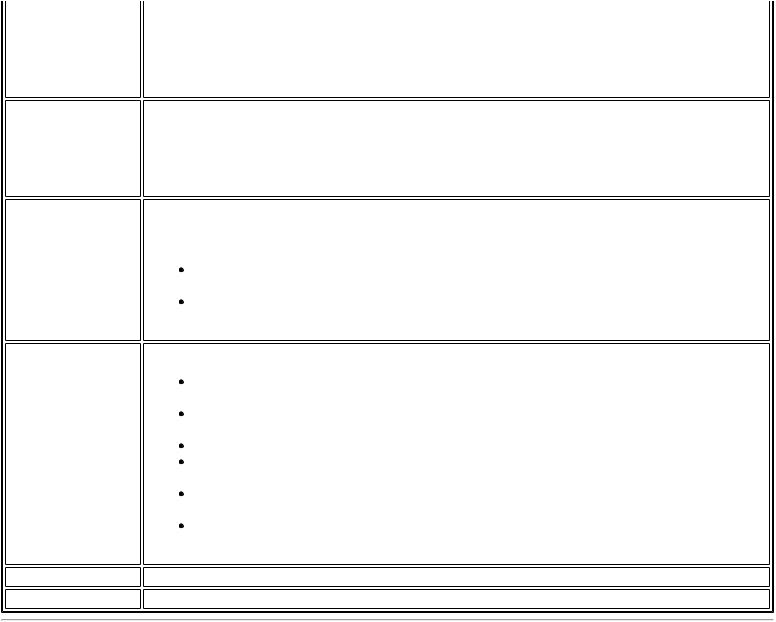
|
possible level that is still compatible with the quality of their communication. This allows the |
|
maximum number of wireless devices to operate in dense areas and reduce interference |
|
with other devices that it shares the same radio spectrum with. |
|
NOTE: This setting takes effect when either Network (Infrastructure) or Device to Device |
|
(ad hoc) mode is used. |
Wake on Magic |
This setting, enabled, wakes the computer from a sleep state when it receives a "magic |
Packet |
packet" from a sending computer. The magic packet contains the MAC address of the |
|
intended destination computer. |
|
Enabling turns on Wake on Magic Packet. Disabling turns off Wake on Magic Packet. |
|
Disabling this only disables the magic packet feature, not Wake on Wireless LAN. |
Wake on |
This feature wakes the computer from a sleep state when a particular wake pattern is |
Pattern Match |
received at the adapter. This feature is supported by the Window* 7 and Windows 8. Such |
|
patterns typically are: |
|
Wake on new incoming TCP connection for IPv4 and IPv6 (TCP SYN IPv4 and TCP SYN |
|
IPv6). |
|
Wake on 802.1x re-authentication packets. |
|
Disabling this only disables the pattern match feature, not Wake on Wireless LAN. |
Wireless Mode |
Select which mode to use for connection to a wireless network: |
|
802.11a only: Connect the wireless WiFi adapter to 802.11a networks only. Not |
|
applicable for all adapters. |
|
802.11b only: Connect the wireless WiFi adapter to 802.11b networks only. Not |
|
applicable for all adapters. |
|
802.11g only: Connect the wireless WiFi adapter to 802.11g networks only. |
|
802.11a and 802.11g: Connect the WiFi adapter to 802.11a and 802.11g networks |
|
only. Not applicable for all adapters. |
|
802.11b and 802.11g: Connect the WiFi adapter to 802.11b and 802.11g networks |
|
only. Not applicable for all adapters. |
|
802.11a, 802.11b, and 802.11g: (Default) - Connect to either 802.11a, 802.11b |
|
or 802.11g wireless networks. Not applicable for all adapters. |
OK |
Saves settings and returns to the previous page. |
Cancel |
Closes and cancels any changes. |
Back to Top
Back to Contents
Trademarks and Disclaimers

Back to Contents
Regulatory Information
This section provides regulatory information for the following wireless adapters:
Intel® Centrino® Wireless-N 100
Intel® Centrino® Wireless-N 105
Intel® Centrino® Wireless-N 130
Intel® Centrino® Wireless-N 135
Intel® Centrino® Wireless-N 1000
Intel® Centrino® Wireless-N 1030
Intel® Centrino® Wireless-N 2200
Intel® Centrino® Wireless-N 2230
Intel® Centrino® Wireless-N + WiMAX 6150
Intel® Centrino® Advanced-N 6200
Intel® Centrino® Advanced-N 6205
Intel® Centrino® Advanced-N 6230
Intel® Centrino® Advanced-N 6235
Intel® Centrino® Advanced-N + WiMAX 6250
Intel® Centrino® Ultimate-N 6300
Intel® Dual Band Wireless-AC 7260
Intel® Dual Band Wireless-N 7260
Intel® Wireless-N 7260
Intel® Dual Band Wireless-AC 3160
Intel® Dual Band Wireless-AC 3165
Intel® Dual Band Wireless-AC 3168
Intel® Dual Band Wireless-AC 7265
Intel® Dual Band Wireless-N 7265
Intel® Wireless-N 7265
Intel® Dual Band Wireless-AC 8260
Intel® Dual Band Wireless-AC 8265
Intel® Wireless-AC 9260
Intel® Wireless-AC 9461
Intel® Wireless-AC 9462
Intel® Wireless-AC 9560
Intel® Tri-Band Wireless-AC 17265
Intel® Tri-Band Wireless-AC 18260
Intel® Tri-Band Wireless-AC 18265
Intel® Wireless Gigabit Sink W13100
Intel® Wireless Gigabit 11000
Intel® Wireless Gigabit Sink W13110VR
Intel® Wireless Gigabit 11100VR
Intel® Wi-Fi 6 AX201
NOTE: Due to the evolving state of regulations and standards in the wireless LAN field (IEEE 802.11 and similar standards), the information provided herein is subject to change. Intel Corporation assumes no responsibility for errors or omissions in this document.
Intel WiFi/WiMAX Wireless Adapters
Information in this section supports the following wireless adapters:
Intel® Centrino® Wireless-N + WiMAX 6150
Intel® Centrino® Advanced-N + WiMAX 6250
See Specifications for complete wireless adapter specifications.
NOTE: In this section, all references to the "wireless adapter" refer to all adapters listed above.

The following information is provided:
Information for the User
Regulatory Information
Regulatory ID
Information for OEMs and Host Integrators
INFORMATION FOR THE USER
Safety Notices
USA FCC Radio Frequency Exposure
The FCC with its action in ET Docket 96-8 has adopted a safety standard for human exposure to radio frequency (RF) electromagnetic energy emitted by FCC certified equipment. The wireless adapter meets the Human Exposure requirements found in FCC Part 2, 15C, 15E along with guidance from KDB 447498, KDB 248227 and KDB 616217. Proper operation of this radio according to the instructions found in this manual will result in exposure substantially below the FCC’s recommended limits.
The following safety precautions should be observed:
Do not touch or move antenna while the unit is transmitting or receiving.
Do not hold any component containing the radio such that the antenna is very close or touching any exposed parts of the body, especially the face or eyes, while transmitting.
Do not operate the radio or attempt to transmit data unless the antenna is connected; this behavior may cause damage to the radio.
Use in specific environments:
The use of wireless adapters in hazardous locations is limited by the constraints posed by the safety directors of such environments.
The use of electronic devices equipped with wireless adapters on airplanes is governed by rules for each commercial airline operator.
The use of wireless adapters in hospitals is restricted to the limits set forth by each hospital.
Explosive Device Proximity Warning
 Warning: Do not operate a portable transmitter (including this wireless adapter) near unshielded blasting caps or in an explosive environment unless the transmitter has been modified to be qualified for such use.
Warning: Do not operate a portable transmitter (including this wireless adapter) near unshielded blasting caps or in an explosive environment unless the transmitter has been modified to be qualified for such use.
Antenna Warnings
 Warning: The wireless adapter is not designed for use with high-gain directional antennas.
Warning: The wireless adapter is not designed for use with high-gain directional antennas.
Use On Aircraft Caution
 Caution: Regulations of commercial airline operators may prohibit airborne operation of certain electronic devices equipped with radio-frequency wireless devices (wireless adapters) because their signals could interfere with critical aircraft instruments.
Caution: Regulations of commercial airline operators may prohibit airborne operation of certain electronic devices equipped with radio-frequency wireless devices (wireless adapters) because their signals could interfere with critical aircraft instruments.
 Caution: 60 GHz/802.11ad equipment is not permitted on aircraft per FCC §15.255. OEM and host integrators should consider this FCC rule in host devices.
Caution: 60 GHz/802.11ad equipment is not permitted on aircraft per FCC §15.255. OEM and host integrators should consider this FCC rule in host devices.
Other Wireless Devices
Safety Notices for Other Devices in the Wireless Network: See the documentation supplied with wireless adapters or other devices in the wireless network.
Local Restrictions on 802.11a, 802.11b, 802.11d, 802.11g, 802.11n, 802.11ac, and 802.16e Radio Usage

 Caution: Due to the fact that the frequencies used by 802.11a, 802.11b, 802.11d, 802.11g, 802.11n, 802.11ac, and 802.16e wireless LAN devices may not yet be harmonized in all countries, 802.11a, 802.11b, 802.11d, 802.11g, 802.11n, 802.11ac, and 802.16e products are designed for use only in specific countries, and are not allowed to be operated in countries other than those of designated use. As a user of these products, you are responsible for ensuring that the products are used only in the countries for which they were intended and for verifying that they are configured with the correct selection of frequency and channel for the country of use. The device transmit power control (TPC) interface is part of the Intel® PROSet/Wireless WiFi Connection Utility Software. Operational restrictions for Equivalent Isotropic Radiated Power (EIRP) are provided by the system manufacturer. Any deviation from the permissible power and frequency settings for the country of use is an infringement of national law and may be punished as such.
Caution: Due to the fact that the frequencies used by 802.11a, 802.11b, 802.11d, 802.11g, 802.11n, 802.11ac, and 802.16e wireless LAN devices may not yet be harmonized in all countries, 802.11a, 802.11b, 802.11d, 802.11g, 802.11n, 802.11ac, and 802.16e products are designed for use only in specific countries, and are not allowed to be operated in countries other than those of designated use. As a user of these products, you are responsible for ensuring that the products are used only in the countries for which they were intended and for verifying that they are configured with the correct selection of frequency and channel for the country of use. The device transmit power control (TPC) interface is part of the Intel® PROSet/Wireless WiFi Connection Utility Software. Operational restrictions for Equivalent Isotropic Radiated Power (EIRP) are provided by the system manufacturer. Any deviation from the permissible power and frequency settings for the country of use is an infringement of national law and may be punished as such.
Wireless Interoperability
The wireless adapter is designed to be interoperable with other wireless LAN products that are based on direct sequence spread spectrum (DSSS) radio technology and to comply with the following standards:
IEEE Std. 802.11b compliant Standard on Wireless LAN
IEEE Std. 802.11g compliant Standard on Wireless LAN
IEEE Std. 802.11a compliant Standard on Wireless LAN
IEEE Std. 802.11n draft 2.0 compliant on Wireless LAN
IEEE 802.16e-2005 Wave 2 compliant
Wireless Fidelity certification, as defined by the Wi-Fi Alliance
WiMAX certification as defined by the WiMAX Forum
The Wireless Adapter and Your Health
The wireless adapter, like other radio devices, emits radio frequency electromagnetic energy. The level of energy emitted by the wireless adapter, however, is less than the electromagnetic energy emitted by other wireless devices such as mobile phones. The wireless adapter operates within the guidelines found in radio frequency safety standards and recommendations. These standards and recommendations reflect the consensus of the scientific community and result from deliberations of panels and committees of scientists who continually review and interpret the extensive research literature. In some situations or environments, the use of the wireless adapter may be restricted by the proprietor of the building or responsible representatives of the applicable organization. Examples of such situations may include:
Using the wireless adapter on board airplanes, or
Using the wireless adapter in any other environment where the risk of interference with other devices or services is perceived or identified as being harmful.
If you are uncertain of the policy that applies to the use of wireless adapters in a specific organization or environment (an airport, for example), you are encouraged to ask for authorization to use the adapter before you turn it on.
REGULATORY INFORMATION
USA - Federal Communications Commission (FCC)
This wireless adapter is restricted to indoor use due to its operation in the 5.15 to 5.25 and 5.470 to 5.75GHz frequency ranges. No configuration controls are provided for Intel® wireless adapters allowing any change in the frequency of operations outside the FCC grant of authorization for U.S. operation according to Part 15.407 of the FCC rules.
Intel® wireless adapters are intended for OEM integrators only.
Intel® wireless adapters cannot be co-located with any other transmitter unless approved by the FCC.
This wireless adapter complies with Part 15 of the FCC Rules. Operation of the device is subject to the following two conditions:
This device may not cause harmful interference.

This device must accept any interference that may cause undesired operation.
Class B Device Interference Statement
This wireless adapter has been tested and found to comply with the limits for a Class B digital device, pursuant to Part 15 of the FCC Rules. These limits are designed to provide reasonable protection against harmful interference in a residential installation. This wireless adapter generates, uses, and can radiate radio frequency energy. If the wireless adapter is not installed and used in accordance with the instructions, the wireless adapter may cause harmful interference to radio communications. There is no guarantee, however, that such interference will not occur in a particular installation. If this wireless adapter does cause harmful interference to radio or television reception (which can be determined by turning the equipment off and on), the user is encouraged to try to correct the interference by taking one or more of the following measures:
Reorient or relocate the receiving antenna of the equipment experiencing the interference.
Increase the distance between the wireless adapter and the equipment experiencing the interference. Connect the computer with the wireless adapter to an outlet on a circuit different from that to which the equipment experiencing the interference is connected.
Consult the dealer or an experienced radio/TV technician for help.
NOTE: The adapter must be installed and used in strict accordance with the manufacturer's instructions as described in the user documentation that comes with the product. Any other installation or use will violate FCC Part 15 regulations.
Safety Approval Considerations
This device has been safety approved as a component and is for use only in complete equipment where the acceptability of the combination is determined by the appropriate safety agencies. When installed, consideration must be given to the following:
It must be installed into a compliant host device meeting the requirement of UL/EN/IEC 60950-1 2nd edition including the general provisions of enclosure design 1.6.2 and specifically paragraph 1.2.6.2 (Fire Enclosure). The device shall be supplied by a SELV source when installed in the end-use equipment.
A heating test shall be considered in the end-use product for meeting the requirement of UL/EN/IEC 60950-1 2nd edition.
Low Halogen
Applies only to brominated and chlorinated flame retardants (BFRs/CFRs) and PVC in the final product. Intel components as well as purchased components on the finished assembly meet JS-709 requirements, and the PCB / substrate meet IEC 61249-2-21 requirements. The replacement of halogenated flame retardants and/or PVC may not be better for the environment.
Japan
5GHz
Korea
.5150-5250MHz .
Mexico
La operación de este equipo está sujeta a las siguientes dos condiciones: (1) es posible que este equipo o dispositivo no cause interferencia perjudicial y (2) este equipo o dispositivo debe aceptar cualquier interferencia, incluyendo la

que pueda causar su operación no deseada.
Taiwan
. .
前項合法通信,
5.25-5.35
Radio Approvals
To determine whether you are allowed to use your wireless network device in a specific country, please check to see if the radio type number that is printed on the identification label of your device is listed in the manufacturer's OEM Regulatory Guidance document.
Modular Regulatory Certification Country Markings
A list of countries requiring regulatory markings is available. Note that the lists include only countries requiring marking but not all certified countries. To find the regulatory country marking information for your adapter, perform these steps:
1.Open this web site: http://www.intel.com/content/www/us/en/support/network-and-i-o/wireless- networking/000007443.html
2.Click on the link for your adapter.
3.Click on Regulatory Marking Document for your adapter.
INFORMATION FOR OEMs and HOST INTEGRATORS
The guidelines described within this document are provided to OEM integrators installing Intel® wireless adapters in notebook and tablet PC host platforms. Adherence to these requirements is necessary to meet the conditions of compliance with FCC rules, including RF exposure. When all antenna type and placement guidelines described herein are fulfilled the Intel® wireless adapters may be incorporated into notebook and tablet PC host platforms with no further restrictions. If any of the guidelines described herein are not satisfied it may be necessary for the OEM or integrator to perform additional testing and/or obtain additional approval. The OEM or integrator is responsible to determine the required host regulatory testing and/or obtaining the required host approvals for compliance.
Intel® wireless adapters are intended for OEMs and host integrators only.
The Intel® wireless adapter FCC Grant of Authorization describes any limited conditions of modular approval. The Intel® wireless adapters must be operated with an access point that has been approved for the country of operation.
Changes or modification to Intel® wireless adapters by OEMs, integrators or other third parties is not permitted. Any changes or modification to Intel® wireless adapters by OEMs, integrators or other third parties will void authorization to operate the adapter.
Antenna Type and Gains
Only antennas of the same type and with equal or less gains as shown below may be used with the Intel® wireless adapters. Other types of antennas and/or higher gain antennas may require additional authorization for operation.
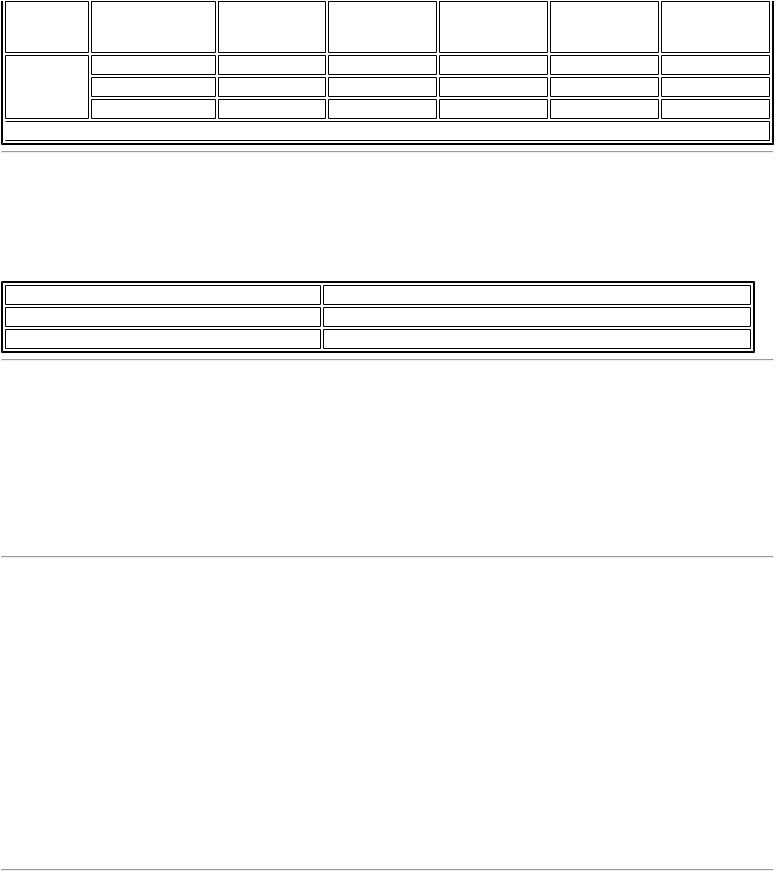
Antenna |
Antenna |
2.4GHz |
2.6GHz |
5.2GHz |
5.5GHz |
5.7GHz |
Type |
Location |
Peak Gain |
Peak Gain |
Peak Gain |
Peak Gain |
Peak Gain |
|
(Main/Aux) |
in dBi* |
in dBi* |
in dBi* |
in dBi* |
in dBi* |
PIFA |
Main |
|
|
|
|
|
|
Aux |
3.24 |
3.47 |
3.73 |
4.77 |
4.77 |
|
MIMO |
|
|
|
|
|
 *All antenna gains include cable loss.
*All antenna gains include cable loss.
Antenna Placement Within the Host Platform
To ensure RF exposure compliance the antenna(s) used with the Intel® wireless adapters must be installed in notebook or tablet PC host platforms to provide a minimum separation distance from all persons, in all operating modes and orientations of the host platform, with strict adherence to the table below. The antenna separation distance applies to both horizontal and vertical orientation of the antenna when installed in the host system.
Intel® Wireless Adapter |
Minimum required antenna-to-user separation distance |
Intel® Centrino® Wireless-N + WiMAX 6150 |
18 mm |
Intel® Centrino® Wireless-N + WiMAX 6350 |
17 mm |
Simultaneous Transmission of Intel® Wireless Adapters with Other Integrated or Plug-In Transmitters
Based upon FCC Knowledge Database publication number 616217 when there are multiple transmitting devices installed in a host device, an RF exposure transmitting assessment shall be performed to determine the necessary application and test requirements. OEM integrators must identify all possible combinations of simultaneous transmission configurations for all transmitters and antennas installed in the host system. This includes transmitters installed in the host as mobile devices (>20 cm separation from user) and portable devices (<20 cm separation from user). OEM integrators should consult the actual FCC KDB 616217 document for all details in making this assessment to determine if any additional requirements for testing or FCC approval is necessary.
Information To Be Supplied to the End User by the OEM or Integrator
The following regulatory and safety notices must be published in documentation supplied to the end user of the product or system incorporating the Intel® wireless adapter, in compliance with local regulations. Host system must be labeled with "Contains FCC ID: XXXXXXXX", FCC ID displayed on label.
The Intel® wireless adapter must be installed and used in strict accordance with the manufacturer's instructions as described in the user documentation that comes with the product. Intel Corporation is not responsible for any radio or television interference caused by unauthorized modification of the devices included with the wireless adapter kit or the substitution or attachment of connecting cables and equipment other than that specified by Intel Corporation. The correction of interference caused by such unauthorized modification, substitution or attachment is the responsibility of the user. Intel Corporation and authorized resellers or distributors are not liable for any damage or violation of government regulations that may arise from the user failing to comply with these guidelines.
China:
Local Restriction of 802.11a, 802.11b, 802.11g, 802.11n, and 802.11e Radio Usage
The following statement on local restrictions must be published as part of the compliance documentation for all 802.11a, 802.11b, 802.11g and 802.11n products.

 Caution: Due to the fact that the frequencies used by 802.11a, 802.11b, 802.11g, 802.11n, and 802.16e wireless LAN devices may not yet be harmonized in all countries, 802.11a, 802.11b, 802.11g, 802.11n, and 802.16e products are designed for use only in specific countries, and are not allowed to be operated in countries other than those of designated use. As a user of these products, you are responsible for ensuring that the products are used only in the countries for which they were intended and for verifying that they are configured with the correct selection of frequency and channel for the country of use. Any deviation from the permissible power and frequency settings for the country of use is an infringement of national law and may be punished as such.
Caution: Due to the fact that the frequencies used by 802.11a, 802.11b, 802.11g, 802.11n, and 802.16e wireless LAN devices may not yet be harmonized in all countries, 802.11a, 802.11b, 802.11g, 802.11n, and 802.16e products are designed for use only in specific countries, and are not allowed to be operated in countries other than those of designated use. As a user of these products, you are responsible for ensuring that the products are used only in the countries for which they were intended and for verifying that they are configured with the correct selection of frequency and channel for the country of use. Any deviation from the permissible power and frequency settings for the country of use is an infringement of national law and may be punished as such.
Intel WiFi Adapters, 802.11n and 802.11ac Compliant
The information in this section applies to the following products:
Intel® Centrino® Wireless-N 100
Intel® Centrino® Wireless-N 105
Intel® Centrino® Wireless-N 130
Intel® Centrino® Wireless-N 135
Intel® Centrino® Wireless-N 1000
Intel® Centrino® Wireless-N 1030
Intel® Centrino® Wireless-N 2200
Intel® Centrino® Wireless-N 2230
Intel® Centrino® Advanced-N 6200
Intel® Centrino® Advanced-N 6205
Intel® Centrino® Advanced-N 6230
Intel® Centrino® Advanced-N 6235
Intel® Centrino® Ultimate-N 6300
Intel® Dual Band Wireless-AC 7260
Intel® Dual Band Wireless-N 7260
Intel® Wireless-N 7260
Intel® Dual Band Wireless-AC 3160
Intel® Dual Band Wireless-AC 3165
Intel® Dual Band Wireless-AC 3168
Intel® Dual Band Wireless-AC 7265
Intel® Dual Band Wireless-N 7265
Intel® Wireless-N 7265
Intel® Dual Band Wireless-AC 8260
Intel® Dual Band Wireless-AC 8265
Intel® Wireless-AC 9260
Intel® Wireless-AC 9461
Intel® Wireless-AC 9462
Intel® Wireless-AC 9560
Intel® Tri-Band Wireless-AC 17265
Intel® Tri-Band Wireless-AC 18260
Intel® Tri-Band Wireless-AC 18265
Intel® Wireless Gigabit Sink W13100
Intel® Wireless Gigabit 11000
Intel® Wireless Gigabit Sink W13110VR
Intel® Wireless Gigabit 11100VR
Intel® Wi-Fi 6 AX201
See Specifications for complete wireless adapter specifications.
NOTE: In this section, all references to the "wireless adapter" refer to all adapters listed above.
The following information is provided:
Information for the User
Regulatory Information
Regulatory ID
Information for OEMs and Host Integrators
Statements of European Compliance

INFORMATION FOR THE USER
Safety Notices
USA FCC Radio Frequency Exposure
The FCC with its action in ET Docket 96-8 has adopted a safety standard for human exposure to radio frequency (RF) electromagnetic energy emitted by FCC certified equipment. The wireless adapter meets the Human Exposure requirements found in FCC Part 2, 15C, 15E along with guidance from KDB 447498, KDB 248227 and KDB 616217. Proper operation of this radio according to the instructions found in this manual will result in exposure substantially below the FCC’s recommended limits.
The following safety precautions should be observed:
Do not touch or move antenna while the unit is transmitting or receiving.
Do not hold any component containing the radio such that the antenna is very close or touching any exposed parts of the body, especially the face or eyes, while transmitting.
Do not operate the radio or attempt to transmit data unless the antenna is connected; this behavior may cause damage to the radio.
Use in specific environments:
The use of wireless adapters in hazardous locations is limited by the constraints posed by the safety directors of such environments.
The use of wireless adapters on airplanes is governed by the Federal Aviation Administration (FAA). The use of wireless adapters in hospitals is restricted to the limits set forth by each hospital.
Explosive Device Proximity Warning
 Warning: Do not operate a portable transmitter (including this wireless adapter) near unshielded blasting caps or in an explosive environment unless the transmitter has been modified to be qualified for such use.
Warning: Do not operate a portable transmitter (including this wireless adapter) near unshielded blasting caps or in an explosive environment unless the transmitter has been modified to be qualified for such use.
Antenna Warnings
 Warning: The wireless adapter is not designed for use with high-gain directional antennas.
Warning: The wireless adapter is not designed for use with high-gain directional antennas.
Use On Aircraft Caution
 Caution: Regulations of commercial airline operators may prohibit airborne operation of certain electronic devices equipped with radio-frequency wireless devices (wireless adapters) because their signals could interfere with critical aircraft instruments.
Caution: Regulations of commercial airline operators may prohibit airborne operation of certain electronic devices equipped with radio-frequency wireless devices (wireless adapters) because their signals could interfere with critical aircraft instruments.
 Caution: 60 GHz/802.11ad equipment is not permitted on aircraft per FCC §15.255. OEM and host integrators should consider this FCC rule in host devices.
Caution: 60 GHz/802.11ad equipment is not permitted on aircraft per FCC §15.255. OEM and host integrators should consider this FCC rule in host devices.
Other Wireless Devices
Safety Notices for Other Devices in the Wireless Network: See the documentation supplied with wireless adapters or other devices in the wireless network.
Local Restrictions on 802.11a, 802.11b, 802.11d, 802.11g, 802.11n, and 802.11ac Radio Usage
 Caution: Due to the fact that the frequencies used by 802.11a, 802.11b, 802.11d, 802.11g, 802.11n, and 802.11ac wireless LAN devices may not yet be harmonized in all countries, 802.11a, 802.11b, 802.11d, 802.11g, 802.11n, and 802.11ac products are designed for use only in specific countries, and are not allowed to be operated in countries other than those of designated use. As a user of these products, you are responsible for ensuring that the products are used only in the countries for which they were intended and for verifying that they are configured with the correct selection of frequency and channel for the country of use. The device transmit power control (TPC)
Caution: Due to the fact that the frequencies used by 802.11a, 802.11b, 802.11d, 802.11g, 802.11n, and 802.11ac wireless LAN devices may not yet be harmonized in all countries, 802.11a, 802.11b, 802.11d, 802.11g, 802.11n, and 802.11ac products are designed for use only in specific countries, and are not allowed to be operated in countries other than those of designated use. As a user of these products, you are responsible for ensuring that the products are used only in the countries for which they were intended and for verifying that they are configured with the correct selection of frequency and channel for the country of use. The device transmit power control (TPC)

interface is part of the Intel® PROSet/Wireless WiFi Connection Utility Software. Operational restrictions for
Equivalent Isotropic Radiated Power (EIRP) are provided by the system manufacturer. Any deviation from the permissible power and frequency settings for the country of use is an infringement of national law and may be punished as such.
Wireless Interoperability
The wireless adapter is designed to be interoperable with other wireless LAN products that are based on direct sequence spread spectrum (DSSS) radio technology and to comply with the following standards:
IEEE Std. 802.11b compliant Standard on Wireless LAN
IEEE Std. 802.11g compliant Standard on Wireless LAN
IEEE Std. 802.11a compliant Standard on Wireless LAN
IEEE Std. 802.11n compliant Standard on Wireless LAN
IEEE Std. 802.11ac draft compliant on Wireless LAN
Wireless Fidelity certification, as defined by the Wi-Fi Alliance
The Wireless Adapter and Your Health
The wireless adapter, like other radio devices, emits radio frequency electromagnetic energy. The level of energy emitted by the wireless adapter, however, is less than the electromagnetic energy emitted by other wireless devices such as mobile phones. The wireless adapter operates within the guidelines found in radio frequency safety standards and recommendations. These standards and recommendations reflect the consensus of the scientific community and result from deliberations of panels and committees of scientists who continually review and interpret the extensive research literature. In some situations or environments, the use of the wireless adapter may be restricted by the proprietor of the building or responsible representatives of the applicable organization. Examples of such situations may include:
Using the wireless adapter on board airplanes, or
Using the wireless adapter in any other environment where the risk of interference with other devices or services is perceived or identified as being harmful.
If you are uncertain of the policy that applies to the use of wireless adapters in a specific organization or environment (an airport, for example), you are encouraged to ask for authorization to use the adapter before you turn it on.
REGULATORY INFORMATION
USA - Federal Communications Commission (FCC)
This wireless adapter is restricted to indoor use due to its operation in the 5.15 to 5.25 and 5.470 to 5.75GHz frequency ranges. No configuration controls are provided for Intel® wireless adapters allowing any change in the frequency of operations outside the FCC grant of authorization for U.S. operation according to Part 15.407 of the FCC rules.
Intel® wireless adapters are intended for OEM integrators only.
Intel® wireless adapters cannot be co-located with any other transmitter unless approved by the FCC.
This wireless adapter complies with Part 15 of the FCC Rules. Operation of the device is subject to the following two conditions:
This device may not cause harmful interference.
This device must accept any interference that may cause undesired operation.
NOTE: The radiated output power of the adapter is far below the FCC radio frequency exposure limits. Nevertheless, the adapter should be used in such a manner that the potential for human contact during normal operation is minimized. To avoid the possibility of exceeding the FCC radio frequency exposure limits, you should keep a distance of at least 20cm between you (or any other person in the vicinity), or the minimum separation distance as specified by the FCC grant conditions, and the antenna that is built into the computer. Details of the authorized configurations can be found at http://www.fcc.gov/oet/ea/

by entering the FCC ID number on the device.
Class B Device Interference Statement
This wireless adapter has been tested and found to comply with the limits for a Class B digital device, pursuant to Part 15 of the FCC Rules. These limits are designed to provide reasonable protection against harmful interference in a residential installation. This wireless adapter generates, uses, and can radiate radio frequency energy. If the wireless adapter is not installed and used in accordance with the instructions, the wireless adapter may cause harmful interference to radio communications. There is no guarantee, however, that such interference will not occur in a particular installation. If this wireless adapter does cause harmful interference to radio or television reception (which can be determined by turning the equipment off and on), the user is encouraged to try to correct the interference by taking one or more of the following measures:
Reorient or relocate the receiving antenna of the equipment experiencing the interference.
Increase the distance between the wireless adapter and the equipment experiencing the interference. Connect the computer with the wireless adapter to an outlet on a circuit different from that to which the equipment experiencing the interference is connected.
Consult the dealer or an experienced radio/TV technician for help.
NOTE: The adapter must be installed and used in strict accordance with the manufacturer's instructions as described in the user documentation that comes with the product. Any other installation or use will violate FCC Part 15 regulations.
Safety Approval Considerations
This device has been safety approved as a component and is for use only in complete equipment where the acceptability of the combination is determined by the appropriate safety agencies. When installed, consideration must be given to the following:
It must be installed into a compliant host device meeting the requirement of UL/EN/IEC 60950-1 2nd edition including the general provisions of enclosure design 1.6.2 and specifically paragraph 1.2.6.2 (Fire Enclosure). The device shall be supplied by a SELV source when installed in the end-use equipment.
A heating test shall be considered in the end-use product for meeting the requirement of UL/EN/IEC 60950-1 2nd edition.
Low Halogen
Applies only to brominated and chlorinated flame retardants (BFRs/CFRs) and PVC in the final product. Intel components as well as purchased components on the finished assembly meet JS-709 requirements, and the PCB / substrate meet IEC 61249-2-21 requirements. The replacement of halogenated flame retardants and/or PVC may not be better for the environment.
Canada – Industry Canada (IC)
This device complies with Industry Canada licence-exempt RSS standard(s). Operation is subject to the following two conditions: (1) this device may not cause interference, and (2) this device must accept any interference, including interference that may cause undesired operation of the device.
Cet appareil se conforme aux normes Canada d'Industrie de RSS permis-exempt. L'utilisation est assujetti aux deux conditions suivantes: (1) cet appareil ne peut pas causer d'interférences, et (2) cet appareil doit accepter des interférences , y compris des interférences qui peuvent causer desopérations non désirées de l'appareil.
Caution: When using IEEE 802.11a wireless LAN, this product is restricted to indoor use due to its operation in the 5.15to 5.25-GHz frequency range. Industry Canada requires this product to be used indoors for the frequency range of 5.15GHz to 5.25GHz to reduce the potential for harmful interference to co-channel mobile satellite systems. High power radar is allocated as the primary user of the 5.25to 5.35-GHz and 5.65 to 5.85-GHz bands. These radar stations can cause interference with and/or damage to this device. The maximum allowed antenna gain for use with this device is 6dBi in order to comply with the E.I.R.P limit for the 5.25to 5.35 and 5.725 to 5.85GHz frequency

range in point-to-point operation. To comply with RF exposure requirements all antennas should be located at a minimum distance of 20cm, or the minimum separation distance allowed by the module approval, from the body of all persons.
Attention: l'utilisation d'un réseau sans fil IEEE802.11a est restreinte à une utilisation en intérieur à cause du fonctionnement dans la bande de fréquence 5.15-5.25 GHz. Industry Canada requiert que ce produit soit utilisé à l'intérieur des bâtiments pour la bande de fréquence 5.15-5.25 GHz afin de réduire les possibilités d'interférences nuisibles aux canaux co-existants des systèmes de transmission satellites. Les radars de puissances ont fait l'objet d'une allocation primaire de fréquences dans les bandes 5.25-5.35 GHz et 5.65-5.85 GHz. Ces stations radar peuvent créer des interférences avec ce produit et/ou lui être nuisible. Le gain d'antenne maximum permissible pour une utilisation avec ce produit est de 6 dBi afin d'être conforme aux limites de puissance isotropique rayonnée équivalente (P.I.R.E.) applicable dans les bandes 5.25-5.35 GHz et 5.725-5.85 GHz en fonctionnement point-à-point. Pour se conformer aux conditions d'exposition de RF toutes les antennes devraient être localisées à une distance minimum de 20 cm, ou la distance de séparation minimum permise par l'approbation du module, du corps de toutes les personnes.
Under Industry Canada regulations, this radio transmitter may only operate using an antenna of a type and maximum (or lesser) gain approved for the transmitter by Industry Canada. To reduce potential radio interference to other users, the antenna type and its gain should be so chosen that the equivalent isotropically radiated power (e.i.r.p.) is not more than that necessary for successful communication.
Selon les règlements de Canada d'Industrie, cet émetteur de radio peut seulement fonctionner en utilisant une antenne du type et de gain maximum (ou moindre) que le gain approuvé pour l'émetteur par Canada d'Industrie. Pour réduire lesinterférences radio potentielles avec les autres utilisateurs, le type d'antenne et son gain devraient être choisis de façon à ce que la puissance isotrope rayonnée équivalente(P.I.R.E.) ne soit pas supérieure à celle qui est nécessaire pour une communication réussie.
European Union
The low band 5.15 - 5.35GHz is for indoor use only.
This equipment complies with the essential requirements of the European Union directive 2014/53/EU. See Statements of European Union Compliance.
European Union Declarations of Conformity
To view the European Union Declaration of Conformity for your adapter, perform these steps.
1.Open this web site: http://www.intel.com/content/www/us/en/support/network-and-i-o/wireless- networking/000007443.html
2.Click on "User Guide."
3.Scroll to your adapter.
To view additional regulatory information for your adapter, perform these steps:
1.Open this web site: http://www.intel.com/content/www/us/en/support/network-and-i-o/wireless- networking/000007443.html
2.Click on the link for your adapter.
3.Click on Regulatory Marking Document for your adapter.
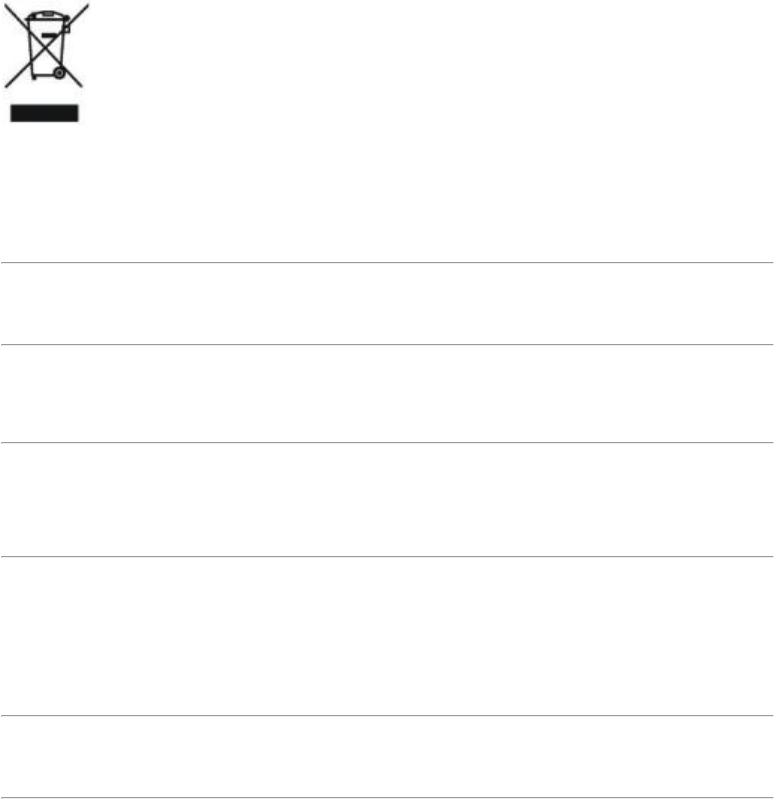
Waste Electrical and Electronic Equipment Directive (WEEE)
Restriction of Hazardous Substances Directive (RoHS) Compliant
All products described herein are compliant with the European Union's RoHS Directive.
For CE Mark-Related Questions related to the wireless adapter, contact:
Intel Corporation Attn: Corporate Quality 2200 Mission College Blvd. Santa Clara, CA 95054-1549 USA
Japan
5GHz
Korea
.5150-5250MHz .
Mexico
La operación de este equipo está sujeta a las siguientes dos condiciones: (1) es posible que este equipo o dispositivo no cause interferencia perjudicial y (2) este equipo o dispositivo debe aceptar cualquier interferencia, incluyendo la que pueda causar su operación no deseada.
Morocco
The operation of this product in the radio channel 2 (2417 MHz) is not authorized in the following cities: Agadir, Assa-Zag, Cabo Negro, Chaouen, Goulmima, Oujda, Tan Tan, Taourirt, Taroudant and Taza.
The operation of this product in the radio channels 4, 5, 6 et 7 (2425 - 2442 MHz) is not authorized in the following cities: Aéroport Mohamed V, Agadir, Aguelmous, Anza, Benslimane, Béni Hafida, Cabo Negro, Casablanca, Fès, Lakbab, Marrakech, Merchich, Mohammédia, Rabat, Salé, Tanger, Tan Tan, Taounate, Tit Mellil, Zag.
Pakistan
"PTA APPROVED MODEL"
Taiwan
. .

,
5.25-5.35
Singapore
Radio Approvals
To determine whether you are allowed to use your wireless network device in a specific country, please check to see if the radio type number that is printed on the identification label of your device is listed in the manufacturer's OEM Regulatory Guidance document.
Modular Regulatory Certification Country Markings
A list of countries requiring regulatory markings is available. Note that the lists include only countries requiring marking but not all certified countries. To find the regulatory country marking information for your adapter, perform these steps:
1.Open this web site: http://www.intel.com/content/www/us/en/support/network-and-i-o/wireless- networking/000007443.html
2.Click on the link for your adapter.
3.Click on Regulatory Marking Document for your adapter.
Regulatory ID
Europe: Models 3160HMW, 3160NGW, 3160SDW, 3165NGW, 7260SDW, 7260NGW, 7260HMW, 7265D2W, 7265NGW, 8260D2W, 8260NGW, 8260NGWH, 18260NGW
Software Version |
Intel® PROSet/Wireless WiFi Software 20.x and subsequent versions |
|
(WiFi/BT) |
|
Intel® Wireless Dock Manager 3.x and previous versions (WiGig) |
Maximum Power Output |
|
(2400 - 2483.5 MHz) |
20dBm EIRP max (100mW) |
IEEE802.11 b/g/n |
|
mode |
|
(2400 - 2483.5 MHz) |
10dBm EIRP max (10mW) |
BLE / Bluetooth |
|
(5150 - 5725 MHz) |
23dBm EIRP max (200mW) |
IEEE802.11 a/n/ac |
The low band 5.15 - 5.35 GHz is for indoor use only |
mode |
|
(5725 - 5875 MHz) |
13.98 dBm EIRP Max (25mW) |
IEEE802.11 a/n/ac |
For the standard EN 300 440, the device operating in 5.8 GHz is considered a category |
mode |
|
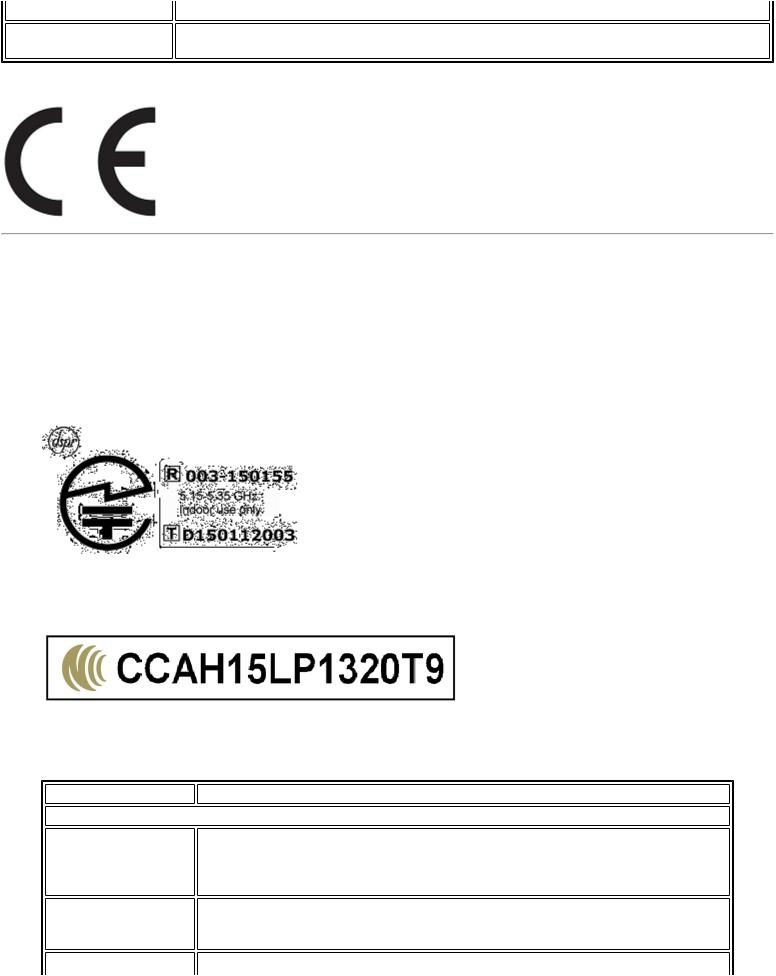
|
2 receiver |
(57 - 64 GHz) |
25 dBm EIRP max |
IEEE802.11 ad mode |
|
This equipment complies with the essential requirements of the European Union directive 2014/53/EU.
Intel® Dual Band Wireless-AC 3165
Due to the very small size of the 3165D2W/3165NGW (12x16), the marking has been placed in this user manual because the product label on the device is considered too small to be readable.
USA: Model 3165D2W, FCC ID: PD93165D2
Canada: Model 3165D2W, IC: 1000M-3165D2
Japan: Model 3165D2W:
Korea: Model 3165D2W, MSIP-CRM-INT-7265D2W
Taiwan: Model 3165D2W,
China: Model 3165D2W, CMIIT ID: 2015AJ3466 (M)
Europe: Model 3165D2W
Software Version |
Intel® PROSet/Wireless WiFi Software 20.x and subsequent versions |
|
Maximum Power Output |
||
(2400 |
- 2483.5 |
20dBm EIRP max (100mW) |
MHz) |
|
|
IEEE802.11 b/g/n |
|
|
mode |
|
|
(2400 |
- 2483.5 |
10dBm EIRP max (10mW) |
MHz) |
|
|
Bluetooth/BLE |
|
|
(5150 |
- 5725 MHz) |
23dBm EIRP max (200mW) |
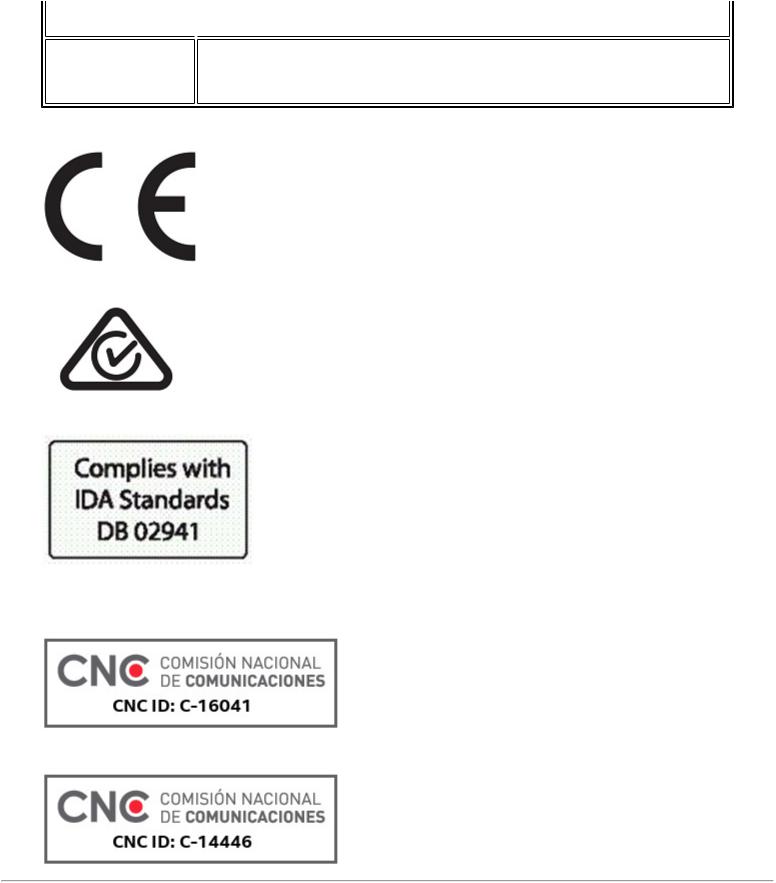
IEEE802.11 a/n/ac mode
(5725 - 5875 MHz) IEEE802.11 a/n/ac mode
 The low band 5.15 - 5.35 GHz is for indoor use only
The low band 5.15 - 5.35 GHz is for indoor use only
13.98 dBm EIRP Max (25mW)
For the standard EN 300 440, the device operating in 5.8 GHz is considered a category 2 receiver
This equipment complies with the essential requirements of the European Union directive 2014/53/EU.
Australia: Model 3165D2W
Singapore: Model 3165D2W
Argentina:
Model 3165D2W,
Model 3165NGW,
Intel® Dual Band Wireless-AC 3168
Due to the very small size of the 3168NGW, the marking has been placed in this user manual because the product label on the device is considered too small to be readable.
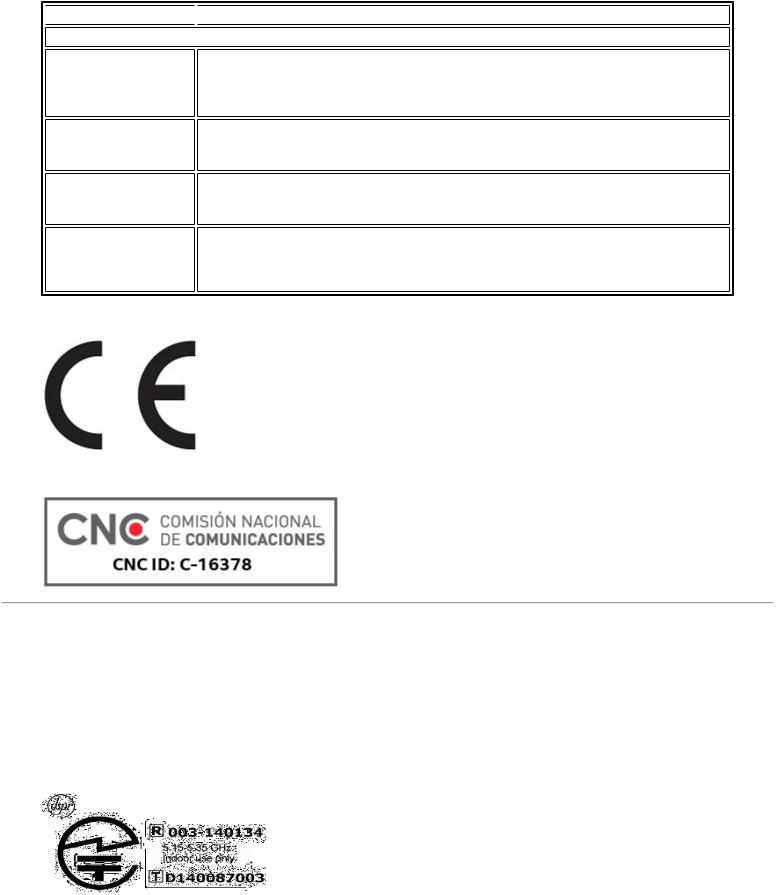
Europe: Model 3168NGW
 Software Version
Software Version  Intel® PROSet/Wireless WiFi Software 20.x and subsequent versions
Intel® PROSet/Wireless WiFi Software 20.x and subsequent versions
Maximum Power Output
(2400 - 2483.5 20dBm EIRP max (100mW) MHz)
IEEE802.11 b/g/n mode
(2400 |
- 2483.5 |
10dBm EIRP max (10mW) |
MHz) |
|
|
Bluetooth/BLE |
|
|
(5150 |
- 5725 MHz) |
23dBm EIRP max (200mW) |
IEEE802.11 a/n/ac |
The low band 5.15 - 5.35 GHz is for indoor use only |
|
mode |
|
|
(5725 - 5875 MHz) IEEE802.11 a/n/ac mode
13.98 dBm EIRP Max (25mW)
For the standard EN 300 440, the device operating in 5.8 GHz is considered a category 2 receiver
This equipment complies with the essential requirements of the European Union directive 2014/53/EU.
Argentina: Model 3168NGW,
Intel® Dual Band Wireless-AC 7265
Due to the very small size of the 7265D2W (12x16), the marking has been placed in this user manual because the product label on the device is considered too small to be readable.
USA: Model 7265D2W, FCC ID: PD97265D2
Canada: Model 7265D2W, IC: 1000M-7265D2
Japan: Model 7265D2W:
Korea: Model 7265D2W, MSIP-CRM-INT-7265D2W

Taiwan: Model 7265D2W,
China: Model 7265D2W, CMIIT ID: 2014AJ3467 (M)
Australia: Model 7265D2W,
Argentina: Model 7265D2W,
Intel® Wireless Gigabit Sink W13100
Due to the very small size of the 13100NGW, the marking has been placed in this user manual because the product label on the device is considered too small to be readable.
Europe: Model 13100NGW
Software Version |
Intel® Wireless Dock Manager 3.x and previous versions |
Maximum Power Output |
|
(57 - 64 GHz) |
25 dBm EIRP max |
IEEE802.11 ad mode |
|
This equipment complies with the essential requirements of the European Union directive 2014/53/EU.
Singapore: Model 13100NGW
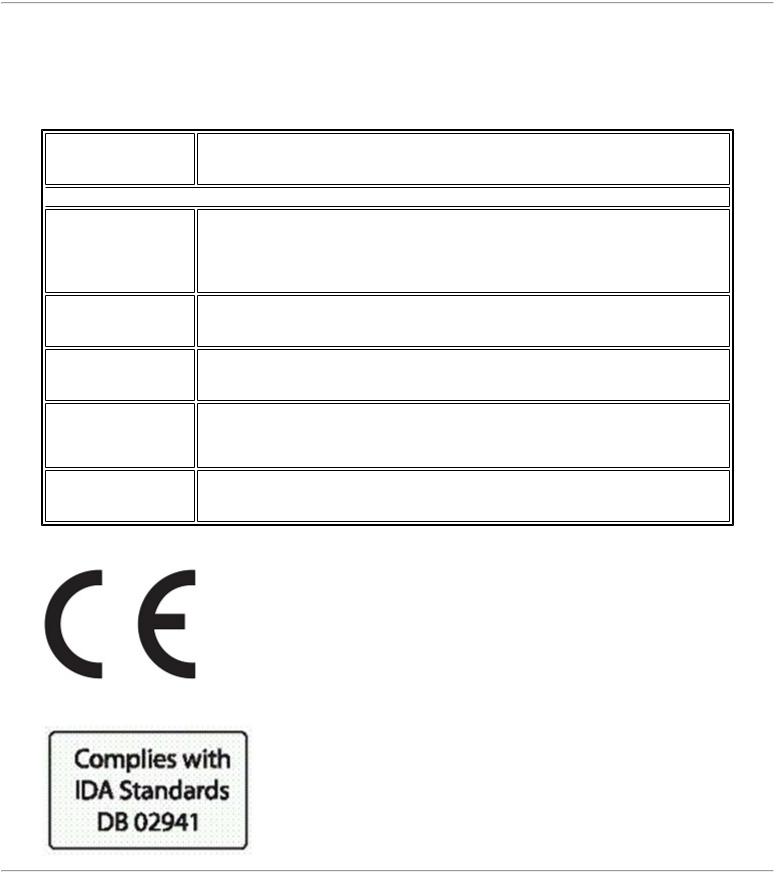
Intel® Tri-Band Wireless-AC 17265
Due to the very small size of the 17265NGW, the marking has been placed in this user manual because the product label on the device is considered too small to be readable.
Europe: Model 17265NGW
Software Version Intel® PROSet/Wireless WiFi Software 20.x and subsequent versions (WiFi/BT)
Intel® Wireless Dock Manager 3.x and previous versions (WiGig)  Maximum Power Output
Maximum Power Output
(2400 - 2483.5 20dBm EIRP max (100mW) MHz)
IEEE802.11 b/g/n mode
Bluetooth
(2400 - 2483.5 |
10dBm EIRP max (10mW) |
MHz) |
|
BLE |
|
(5150 - 5725 MHz) |
23dBm EIRP max (200mW) |
IEEE802.11 a/n/ac |
The low band 5.15 - 5.35 GHz is for indoor use only |
mode |
|
(5725 - 5875 MHz) IEEE802.11 a/n/ac mode
13.98 dBm EIRP Max (25mW)
For the standard EN 300 440, the device operating in 5.8 GHz is considered a category 2 receiver
(57 - 64 GHz) |
25 dBm EIRP max |
IEEE802.11 ad |
|
mode |
|
This equipment complies with the essential requirements of the European Union directive 2014/53/EU.
Singapore: Model 17265NGW
Intel® Dual Band Wireless-AC 8260
Due to the very small size of the 8260D2W (12x16), the marking has been placed in this user manual because the product label on the device is considered too small to be readable.

USA: Model 8260D2W, FCC ID: PD98260D2 (FCC ID without suffix "U" denotes factory installation only);
FCC ID: PD98260D2U (FCC ID with suffix “U” denotes user installation or replacement permitted and supported by bios locking feature)
Canada: Model 8260D2W, IC: 1000M-8260D2
Japan: Model 8260D2W:
Korea: Model 8260D2W, MSIP-CRM-INT-8260D2W
Taiwan: Model 8260D2W,
China: Model 8260D2W, CMIIT ID: 2014AJ3467 (M)
Australia: Model 8260D2W,
Argentina: Model 8260D2W,
Due to the very small size of the 8260NGWH/8260NGW, the marking has been placed in this user manual because the product label on the device is considered too small to be readable.
Argentina: Model 8260NGWH,
Argentina: Model 8260NGW,
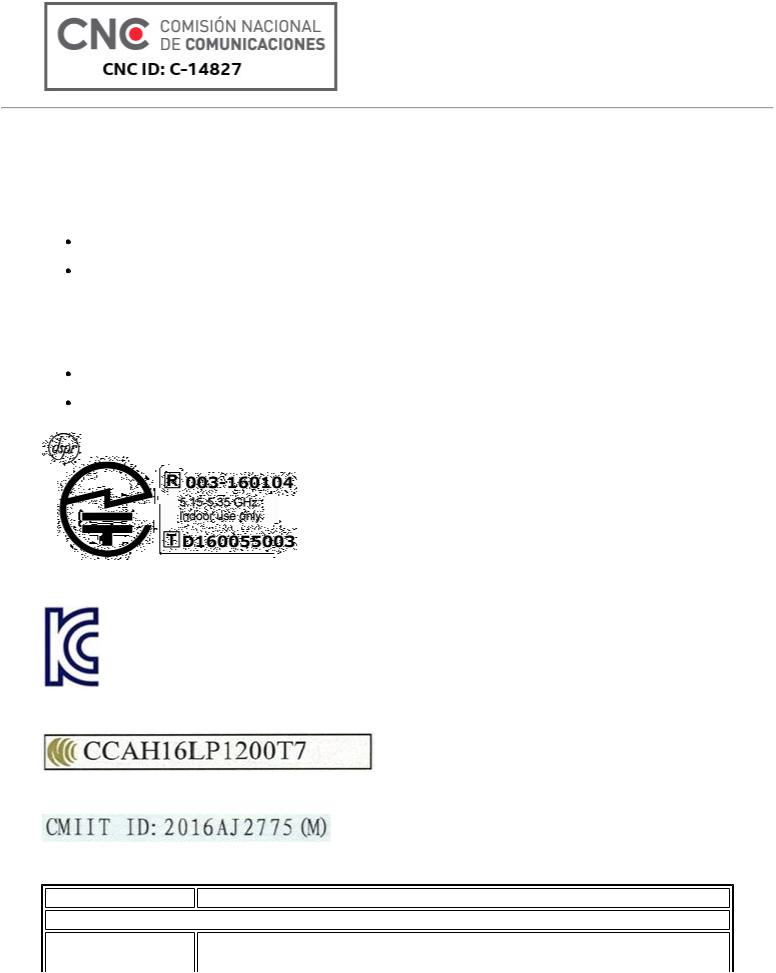
Intel® Dual Band Wireless-AC 8265
Due to the very small size of the 8265NGW (22mm x 30mm x 2.4mm), the marking has been placed in this user manual because the product label on the device is considered too small to be readable.
USA: Model 8265NGW
FCC ID: PD98265NG (FCC ID without suffix "U" denotes factory installation only)
FCC ID: PD98265NGU (FCC ID with suffix “U” denotes user installation or replacement permitted and supported by BIOS locking feature)
Canada: Model 8265NGW, IC: 1000M-8265NG
Japan: Model 8265NGW:
RF 003-160104
TEL D160055003
Korea: Model 8265NGW, MSIP-CRM-INT-8265NGW,
Taiwan: Model 8265NGW
China: Model 8265NGW
Europe: Models 8265NGW, 8265D2W
Software Version |
Intel® PROSet/Wireless WiFi Software 20.x and subsequent versions |
Maximum Power Output |
|
(2400 - 2483.5 |
20dBm EIRP max (100mW) |
MHz) |
|
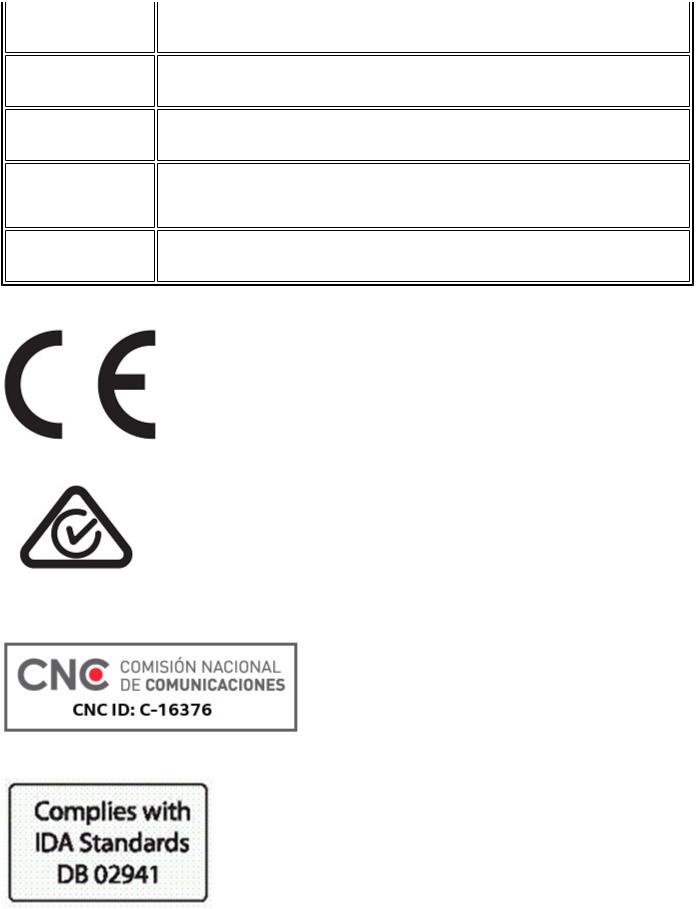
IEEE802.11 b/g/n mode
Bluetooth
(2400 - 2483.5 |
10dBm EIRP max (10mW) |
MHz) |
|
BLE |
|
(5150 - 5725 MHz) |
23dBm EIRP max (200mW) |
IEEE802.11 a/n/ac |
The low band 5.15 - 5.35 GHz is for indoor use only |
mode |
|
(5725 - 5875 MHz) IEEE802.11 a/n/ac mode
(57 - 64 GHz) IEEE802.11 ad mode
13.98 dBm EIRP Max (25mW)
For the standard EN 300 440, the device operating in 5.8 GHz is considered a category 2 receiver
25 dBm EIRP max
This equipment complies with the essential requirements of the European Union directive 2014/53/EU.
Australia: Model 8265NGW,
Brazil: Model 8265NGW: ANATEL: XXXXXXXXXX,
Argentina: Model 8265NGW,
Singapore: Model 8265NGW:
Pakistan: Model 8265NGW
"PTA APPROVED MODEL"

Due to the very small size of the 8265D2W (12mm x 16mm x 1.8mm), the marking has been placed in this user manual because the product label on the device is considered too small to be readable.
USA: Model 8265D2W, FCC ID: PD98265D2
Canada: Model 8265D2W, IC: 1000M-8265D2
Japan: Model 8265D2W:
RF 003-160129
TEL D160076003
Korea: Model 8265D2W, MSIP-CRM-INT-8265D2W,
Taiwan: Model 8265D2W
China: Model 8265D2W
Australia: Model 8265D2W,
Brazil: Model 8265D2W: ANATEL: XXXXXXXXXX,
Argentina: Model 8265D2W,
Singapore: Model 8265D2W:
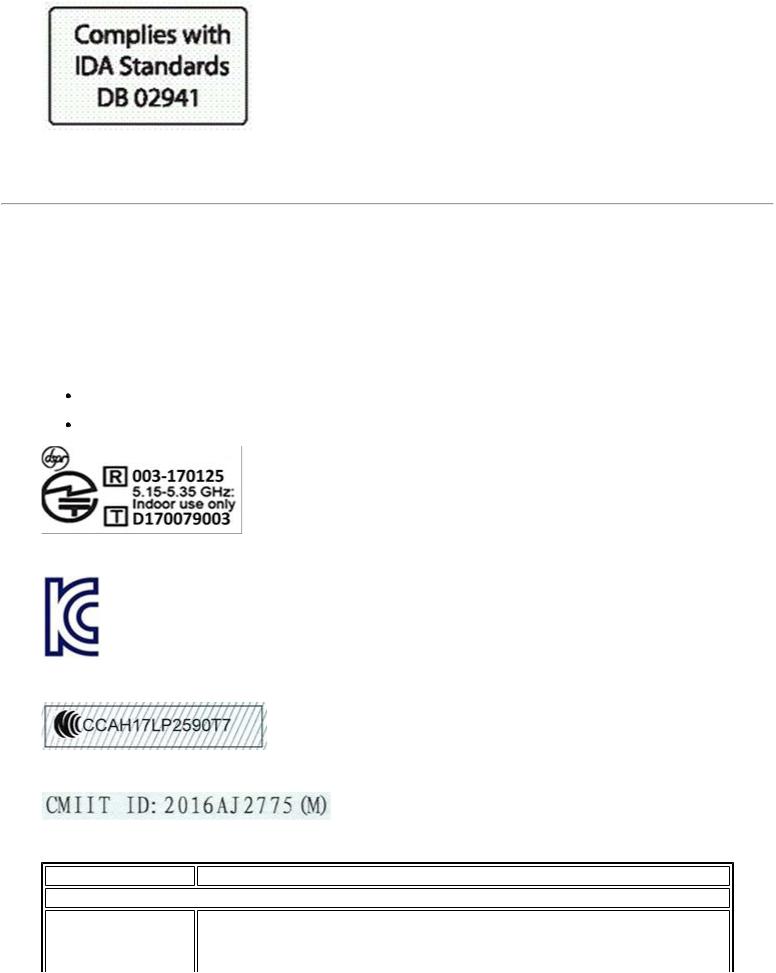
Pakistan: Model 8265D2W
"PTA APPROVED MODEL"
Intel® Wireless-AC 9260
Due to the very small size of the 9260NGW (22mm x 30mm x 2.4mm), the marking has been placed in this user manual because the product label on the device is considered too small to be readable.
USA: Model 9260NGW, FCC ID: PD99260NG
Canada: Model 9260NGW, IC: 1000M-9260NG
Japan: Model 9260NGW:
RF 003-170125
TEL D170079003
Korea: Model 9260NGW, MSIP-CRM-INT-9260NGW
Taiwan: Model 9260NGW
China: Model 9260NGW
Europe: Model 9260NGW
Software Version |
Intel® PROSet/Wireless WiFi Software 20.x and subsequent versions |
Maximum Power Output |
|
(2400 - 2483.5 |
20dBm EIRP max (100mW) |
MHz) |
|
IEEE802.11 b/g/n |
|

mode
Bluetooth
(2400 - 2483.5 |
10dBm EIRP max (10mW) |
MHz) |
|
BLE |
|
(5150 - 5725 MHz) |
23dBm EIRP max (200mW) |
IEEE802.11 a/n/ac |
The low band 5.15 - 5.35 GHz is for indoor use only |
mode |
|
(5725 - 5875 MHz) IEEE802.11 a/n/ac mode
13.98 dBm EIRP Max (25mW)
For the standard EN 300 440, the device operating in 5.8 GHz is considered a category 2 receiver
This equipment complies with the essential requirements of the European Union directive 2014/53/EU.
Australia: Model 9260NGW
Singapore: Model 9260NGW
Intel® Wireless-AC 9461 (Model 9461NGW)
Due to the very small size of the 9461NGW (22mm x 30mm x 2.4mm), the marking has been placed in this user manual because the product label on the device is considered too small to be readable.
USA: Model 9461NGW, FCC ID: PD99461NG
Canada: Model 9461NGW, IC: 1000M-9461NG
Japan: Model 9461NGW:
RF 003-170204
TEL D170127003
